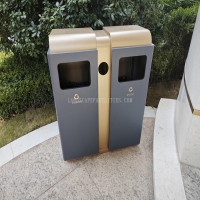Welcome to the website for landscape facilities products and knowledge.
How do landscape round trash cans accommodate the needs of users with disabilities?
Landscape round trash cans are a common sight in public spaces, but their design often goes unnoticed until accessibility becomes a concern. For users with disabilities, these trash cans must meet specific requirements to ensure ease of use and inclusivity. Here’s how they accommodate diverse needs:
1. Height and Reachability: ADA (Americans with Disabilities Act) guidelines recommend that trash cans be placed at a height accessible to wheelchair users, typically no higher than 48 inches. Round trash cans with open tops or side openings allow easy disposal without straining.
2. Stable and Secure Placement: To prevent tipping, these trash cans are often anchored or weighted. This stability is crucial for individuals who rely on canes or walkers, as it reduces the risk of accidents.
3. Tactile and Visual Cues: For visually impaired users, contrasting colors or tactile indicators help locate and identify trash cans. Some designs include Braille labels or raised symbols to enhance usability.
4. Foot Pedals or Sensor-Based Lids: Hands-free operation via foot pedals or motion sensors benefits those with limited hand mobility, ensuring hygienic and effortless disposal.
5. Strategic Placement: Trash cans are positioned along accessible pathways, avoiding obstructions like stairs or narrow gaps, making them reachable for everyone.
By integrating these features, landscape round trash cans contribute to creating inclusive, user-friendly environments that prioritize accessibility for all.
Related search:

Recommendation
Double-bucket garbage bin, outdoor, metal, multi-color, powder-coated, double-bucket trash can